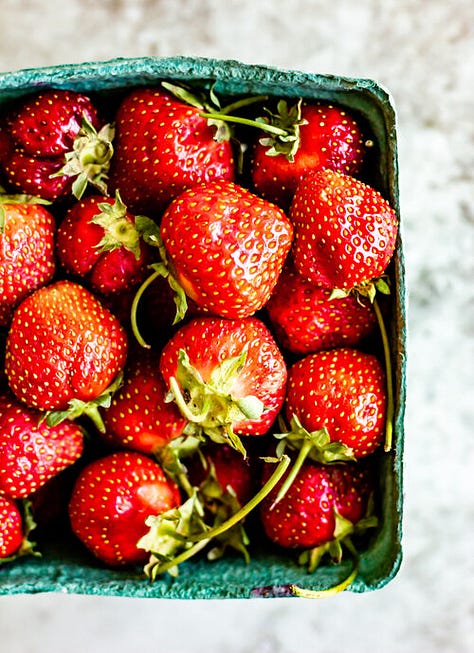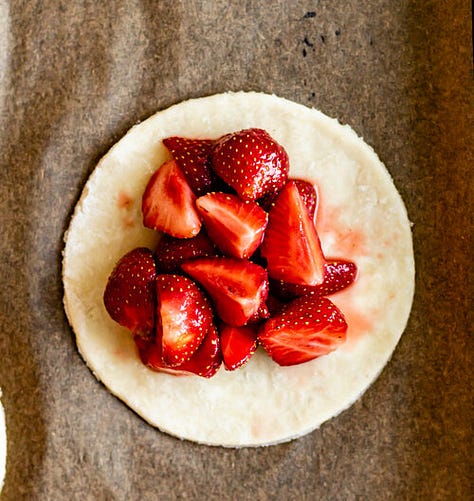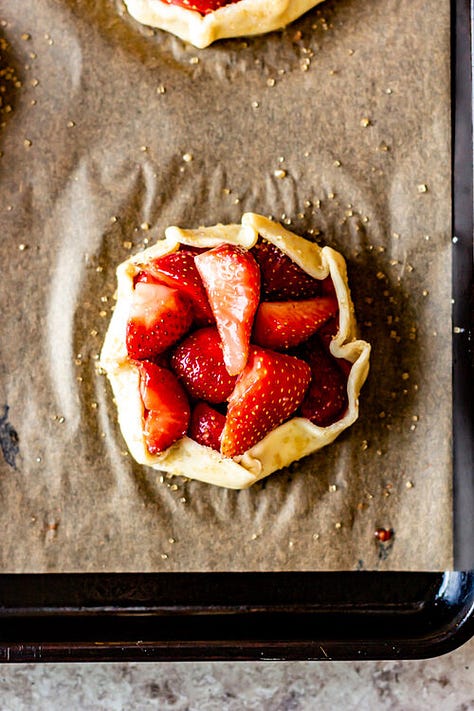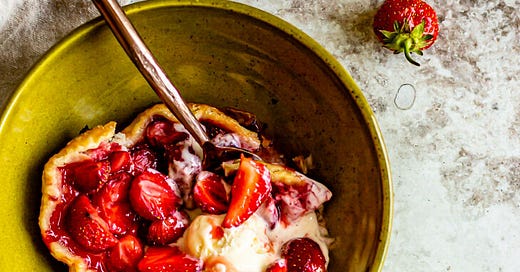It’s officially summer and I know this because every time I step into my kitchen, I start to sweat. Our tiny little kitchen is tucked away in the back of our house, with the stove smushed in right next to our back door. With a dog and toddler running afoot, it seems that the back door is always opening and closing, ushering in gusts of warm, sticky air. In the spring and fall, my setup is perfect because I can prop the backdoor open and watch the boys play while I cook or work just inside, being gently caressed by a cool breeze. But alas, that time has passed, the mosquitos have arrived and I’m turning to my favorite summer dessert category—crisps, crumbles, and cobblers, also known as “easy recipes you can throw together in minutes and do not have to be anywhere near the stove while they bake” desserts.
As I was planning this newsletter, I spent a little time researching ‘official’ definitions of each of these desserts to see if what the internet has to say matches up with my definitions and I stumbled across this comment on a Reddit thread: “The entire world of cobbler/crumble/buckle/betty/pandowdys/slumps/grunts/etc are just a mess of Grandma’s recipes and people’s childhoods. You’ll never find a perfect definition for any of them.” I agree with the user Prettyplum32 and have also never heard of slumps and grunts so I guess we’re learning something new every day.
That being said, I am going to attempt to loosely categorize these desserts based on my textbooks definitions from culinary school, a little historical research, my personal experiences with them, and vibes. Let’s jump in!
fruit with streusel topping
I’d argue that the streusel-topped desserts—crisp, crumble, and betty— are the simplest. Juicy fruit, tossed with a smattering of sugar, and topped with some combination of butter, brown sugar, oats, and nuts baked until bubbly and deeply browned. I would define the differences this way: a crumble is a flour, butter, sugar topping, while a crisp includes oats and nuts. Very traditionally, a betty uses breadcrumbs or bread pieces, but is often more streusel-like, and the topping is layered with the fruit like a lasagna.
fruit with biscuit topping
My family is from North Carolina so we make cobblers. My mom’s cobbler was often peach, topped with sweetened Bisquick dollops and baked until golden. Always served with ice cream. The term ‘cobbler’ comes from its rough aesthetic, as though the dough has been ‘cobbled’ together in comparison to the smooth top of a pie crust. This week, I learned about grunts and slumps—an interchangeable name originating in New England for fruit topped with biscuit dough and cooked in a covered pot on the stove. And apparently my North Carolinian roots are not deep enough to know about the sonker. A sonker is a North Carolina-specific version of a cobbler that consists of fruit with a pancake style batter poured over top—so a Southern style clafoutis?? We’ll be exploring this more for sure.
fruit with cake topping
A buckle is another New England-originated dessert that sort of resembles a coffee cake. A cake batter is poured in a baking dish and then topped with fruit (and often streusel) and as the cake bakes, it begins to ‘buckle’ under the weight of the fruit. Serve it warm with a dusting of powdered sugar.
fruit with pie crust (top or bottom)
Lazy pie crust desserts include galettes and crostatas, the French and Italian words for the same dessert—ripe fruit piled onto a round of pie crust, the edges folded in to create a little bowl and baked. A pie without any of the latticing or rolling out of multiple pie doughs. A pandowdy is more like a double crusted pie, but as soon as the pie comes out of the oven, a spoon is used to break and smush the top crust into the fruit so that it absorbs the fruit juices. All of these should of course be served warm with generous scoops of ice cream.
bonus: fruit with custard
Finally, I feel like a clafoutis at least belongs a bit in this conversation. A clafoutis is a classically French dessert of fruit with a custard-like topping poured over and baked. The texture falls somewhere between a cake and a flan.
elevating your fruit + pastry desserts
I love all of these desserts because they are both easy and versatile. You can adapt any recipe to suit whatever fruit you’d like and it’s easy to elevate the flavor. You can incorporate fresh herbs, spices, and zests into either the fruit portion or the pastry portions—or both! I love pairing rosemary or thyme with dark fruits (cherries and blackberries); floral flavors like earl grey and lavender go well with blueberries and raspberries; bright basil plays well with strawberries and stone fruits (peaches and nectarines); and citrus zest goes with almost anything!



double strawberry galettes
makes one 9” inch galette or 4 individual galettes
Ingredients:
for the pie crust
1/2 cup + 2 tbsp (82 g) all purpose flour
1/2 cup + 2 tbsp (70 g) cake flour
2 tsp granulated sugar
1/4 tsp kosher salt
1/2 cup (113 g) unsalted butter, cold
4 tbsp of ice water
for the strawberry filling
1 batch pie dough, recipe included
1 lb fresh strawberries
2 tbsp sugar
Juice of 1/2 of a lemon
1 tsp cornstarch
Egg wash
2 tbsp demerara sugar
Procedure:
to make the pie crust
Cube butter and place in a bowl in the freezer while you prepare the rest of the ingredients.
In a large bowl, whisk together flour, cake flour, sugar, and salt.
Add the butter cubes to the bowl with the dry ingredients and toss them to coat. Using your thumbs and forefinger, flatten each butter piece and begin to work them into the dough until they are the size of black beans. When all of the butter has has been broken down, make a well in the center of the bowl.
Add 3 tbsp of ice water to the bowl and use your fingertips gently toss the mixture until combined. Begin gently kneading the dough, taking care not to overwork it, and adding another tablespoon of water if needed. To test if the dough is moist enough, grab a handful and squeeze it together. If the dough stays clumped together when you open your hand, your dough is ready. If not, add a bit more water and knead a little more.
Turn your dough onto a clean work surface and use the heel of your hand to continue gently kneading until there are no more dry patches of flour, but streaks of butter are still visible.
Press dough into a disc, wrap in plastic wrap, and chill for at least an hour.
When the dough is ready, roll it out on a floured work surface until it is about 1/4” thick.
If making one large galette: roll the dough into a circle, roughly 10” in diameter.
If making miniature galettes: use a ring or cake pan to cut four 6” circles out of the dough.
Place on a parchment lined baking sheet and return to the refrigerator until you are ready to fill and bake.
to make the galettes
Preheat the oven to 400° F.
Remove the green stems from the strawberries and quarter them. Place berries in a large bowl and toss with sugar, cornstarch, and lemon juice until all of the berries are well-coated. Let rest for 15 minutes.
For one large galette: Spoon half of the berry mixture onto the center of your prepared pie crust, leaving at least 1” border around the edge. Fold the edges of the galette up and over the fruit and press to seal. Brush the edges with egg wash and sprinkle with Demerara sugar.
For miniature galettes: Spoon about 1/4 cup of berry mixture into the center of each pie crust and fold the edges up and over the fruit. Press to seal and then brush with egg wash and sprinkle with demerara sugar.
Bake the galettes for 25-28 minutes, until the crust is deeply golden brown and the fruit mixture is bubbling.
Remove from the oven and let cool to room temperature. Serve with vanilla ice cream and a spoonful of the remaining macerated berries.







